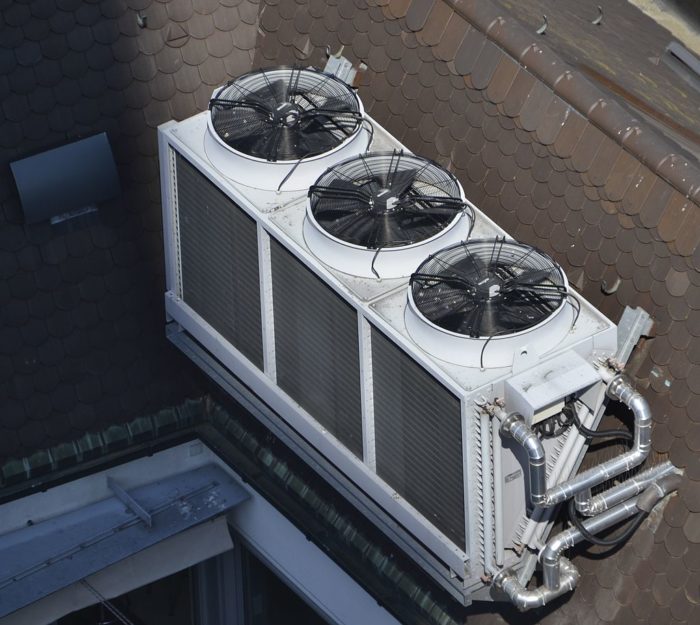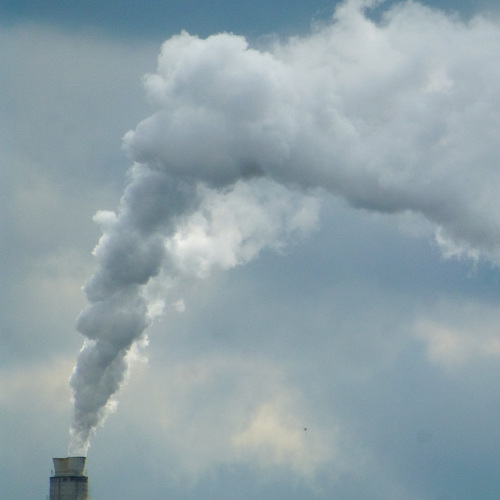
Image Credit: Wikimedia Commons
More efficient commercial AC
New efficiency requirements for commercial air conditioners and furnaces announced by the U.S. Department of Energy are the most aggressive ever approved by the agency and will cut $167 billion in spending over the next 30 years.
Greentech Media reported that the new standards, announced last month, will save the owner of a typical rooftop air conditioner between $5,000 and $10,000 over the life of the equipment. But savings will be greater for owners of larger systems, like a big-box retailer with 20 or more rooftop units.
Beginning in 2018, AC units will have to be 13% more efficient than they are today. By 2023, equipment must be 25% to 30% more efficient, Greentech Media said. Commercial gas furnaces will have to be 81% efficient by 2023; thermal efficiency for oil-burning furnaces will have to reach 82% by that date.
The DOE said in a press release that the new standards would reduce carbon pollution by 885 million metric tons over 30 years.
These are the latest in a series of updated standards released by the DOE during the Obama administration. More than 40 household and commercial products have been affected, collectively saving consumers nearly $535 billion and reducing greenhouse gas emissions by more than 2 billion metric tons through 2030, the government said.
Commercial air conditioners are common on schools, retail stores, and small office buildings, and cool about half of all commercial floor space in the country.
Alliance seeks a ban on fuel-burning vehicles
An alliance of eight U.S. states, four European countries, and two Canadian provinces is calling for the elimination of passenger cars that burn fossil fuels in their jurisdictions by 2050.
The Zero-Emission Vehicles Alliance was created to give its members better access to ideas on how to successfully promote electric vehicles, according to a report by E&E Publishing. The alliance includes California, Connecticut, Maryland, Massachusetts, New York, Oregon, Rhode Island, Vermont, Quebec, British Columbia, Germany, Norway, the Netherlands, and the United Kingdom.
Alliance partners said that the pledge to do away with vehicles burning gasoline or diesel would improve air quality and ease global climate change. But the sale of electric vehicles so far has fallen well short of Obama administration goals, and auto industry leaders doubt that U.S. members of the alliance have tough enough regulations on the books to meet even an existing mandate to get 3.3 million electric vehicles on the road by 2025.
For example, E&E reported, California would have to see 1.5 million more electric vehicles in 10 years in order to comply with the 2025 goal, 10 times the number of zero-energy vehicles currently on the road.
Still, the alliance said that its members account for about half of global zero-emissions vehicles sales and that a wider adoption of the technology will accelerate consumer demand and lower costs. The group announced its new goal at the Paris climate talks last month.
In Colorado, a sewage plant that powers vehicles
Grand Junction, Colorado, may be the first community in the country to turn methane produced at its municipal sewage treatment plant into fuel for its fleet of garbage trucks and city buses, National Public Radio reports.
The wastewater treatment plant had been burning off the methane produced as sewage was processed, which plant manger Dan Tonello said was “not good for the environment and a waste of a wonderful resource.” Now, the gas is refined until it is chemically identical to the natural gas produced in a drilled well.
The city has been using the gas to run garbage trucks and buses as it modernizes its fleet of vehicles, saving the city hundreds of thousands of dollars per year, Tonello said.
Colorado also is the site of a new biogas facility, now nearing completion, that will process food waste from restaurants, grocery stores, and large food manufacturers. The plant will be one of the largest in North America, capable of processing 25 to 30 truckloads of food waste by mixing it with manure from a local dairy farm.
The “renewable natural gas” produced by the new plant will be distributed by the same pipelines used to deliver fossil fuels, NPR said.
Weekly Newsletter
Get building science and energy efficiency advice, plus special offers, in your inbox.













4 Comments
Condensing Natural Gas Furnace Technology
"Commercial gas furnaces will have to be 81% efficient by 2023". Residential condensing nat gas furnace AFUE of 92%-96% has been readily available for years, at modest incremental equipment cost and high equipment reliability. Perhaps the DOE is setting a very low bar for this nat gas commercial furnace 2023 standard?
It's not much different from the residential minimums.
IIRC the Federal minimum standard for residential gas fired units is 78% up until the beginning of 2015, 80-83% for anything manufactured after 1 January 2015. This is just harmonizing the standards for commercial minimum efficiency with residential minimum efficiency.
The DOE had proposed a minimum of 90% AFUE for the north, 80% for the south for residential efficiency, then more recently a 92% AFUE minimum. Some states have established higher minimum AFUE in state codes, but it's still 80-81% for gas, 78-83% for oil. depending on furnace type/class. See:
https://www1.eere.energy.gov/buildings/appliance_standards/product.aspx/productid/72#historicalinformation
Just as building a house to code minimum is the crummiest house that is still legal to build, buying the legal minimum efficiency equipment is the crummiest equipment that's still legal to install, but that's not to say it's the optimum, or that there isn't much better equipment available. (There clearly IS better commercial & residential equipment out there.)
In many cases, I don't
In many cases, I don't believe these "improvements" which save you utility dollars actually save you total dollars. Sure washing machines are much more efficient and save me hundreds of gallons of water but what used to be a $250 appliance all day long is now regularly a $1,000 appliance or more. What used to last 25 years now is lucky to make it 10. Consumers may be gaining energy efficiency but the total life cycle cost is likely more than the wasteful appliances of yore. The same applies to refrigerators which were a $250-$300 appliance that would easily last 30 years. You'll go through 3 of them now in the same time span at $1,200 or more each.
BTW, I've been married 27
BTW, I've been married 27 years and we are now on our 4th washing machine so I was a little optimistic when I said they last 10 years.
Log in or create an account to post a comment.
Sign up Log in